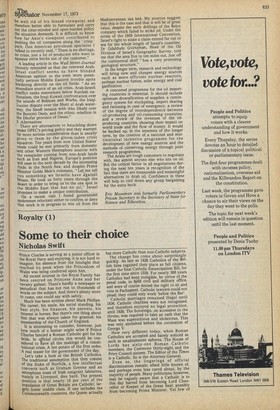Royalty (1)
Some to their choice
Nicholas Swift
Prince Charles is serving as a junior officer in the Royal Navy and enjoying, it is not hard to imagine, his absence from the limelight that reached its peak when the Princedom of Wales was being conferred upon him.
All recent interest in the Royal Family has been centred on Princess Anne and her cavalry gallant. There's hardly a newpaper or Periodical that has not run to thousands of words on the subject. And there's plenty more to come, one could say with safety.
Much has been written about Mark Phillips. His career, his smile, his social standing, his hair style, his finances, his parents, his interest in horses. But there's one thing about him that was always taken for granted; his membership of the Church of England.
It is interesting to consider, however, just how much of a bother might arise if Prince Charles fancied a Roman Catholic girl for his bride. In official circles this would be considered to have all the makings of a constitutional crisis. A hot potato of the first order. A real teaser for the government of the day.
Let's take a look at the British Catholics. The traditional assumption that they consist of the Duke of Norfolk, a few intellectual converts such as Graham Greene and an amorphous mass of Irish emigrant labourers, mainly in Liverpool, dies hard. The present Position is that nearly 10 per cent of the Population of Great Britain are Catholic; larply lower middle class. If one includes the Commonwealth countries, the Queen actually has more Catholic than non-Catholic subjects.
The change has come about surprisingly quickly. As late as 1826 Catholics of the British Isles regained their place as full citizens, under the final Catholic Emancipation Bill, for the first time since 1559. For nearly 300 years Catholics had been ineligible, by virtue of the penal code, to hold civil and military office, and were of course denied the right to sit and vote in Parliament. Catholic lawyers could not plead; they could only work 'below the Bar'. Catholic marriages remained illegal until 1836. Catholic charities were not recognised, and therefore enjoyed no legal protection, until 1926. The Sovereign, on accession to the throne, was required to take an oath that the Mass was superstitious and idolatrous. This was only abolished before the coronation of George V.
How very different today, when Roman Catholics are accepted and barely noticed as such in establishment spheres. The House of Lords has sixty-one Roman Catholic members, the Commons thirty-eight, and the Privy Council sixteen. The Editor of the Times is a Catholic. So is the Attorney-General.
Even so, the lingerings of official discrimination remain; albeit little known of, and perhaps even less cared about, by the majority of people. Many politicians, however, may be vaguely aware that a Catholic is to this day barred from becoming Lord Chancellor or Keeper of the Great Seal: possibly from-becoming Prime Minister. Yet few of
them might, in our tolerant age, be enthusiastic in their support for this particular law if it was called in question.
The law of the land also provides that certain members of the Royal Family may not be Catholics. The younger generation in this country is most tolerant of all; and influential. They might show even less enthusiasm for the law if one of their royal contemporaries wanted to marry a Catholic and was legally barred from so doing. • Necessarily, the shaping of the law follows well behind changes in public attitudes. Every . now and then it is so far behind that hasty amendment becomes less embarrassing than obdurate enforecement.
The choice in marriage of the Prince of Wales could, conceivably, make the law look quaint. If by any chance Miss X happens to be a Roman Catholic, two things are absolutely certain. The media will have a story, and the legal lions will have a problem. It may never happen, of course, but in terms of historical and political evolution the mere possibility is, in 1973, an intriguing thought.



































 Previous page
Previous page